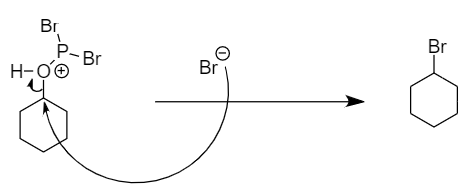Question
Question: Cyclohexanol on reaction with \( PB{r_3} \) in the presence of pyridine gives: (A) Bromocyclohexen...
Cyclohexanol on reaction with PBr3 in the presence of pyridine gives:
(A) Bromocyclohexene
(B) Bromocyclohexane
(C) 1− bromocyclohexanol
(D) None of the above
Solution
Hint : Nucleophilic reactions: These are the type of organic reactions in which a nucleophile i.e., an electron rich species attacks the electron deficient carbon atom and the functional group attached to that carbon is replaced.
Complete Step By Step Answer:
As per given reaction conditions, when cyclohexanol reacts with PBr3 in the presence of pyridine, it follows SN2 nucleophilic substitution reaction.
Bimolecular nucleophilic reaction (SN2) : These are the nucleophilic reactions in which the rate of reaction depends on both, the nucleophile as well as the reactant taken. In these reactions, bond formation and breaking of bonds takes place simultaneously. So, it is a single step or concerted reaction.
The reaction mechanism is as follows:
Step-1: The lone pair of electrons present on the oxygen atom attack the phosphorus atom and removal of bromine ion takes place. The reaction is as follows:

Step-2: The bromine ion will act as a nucleophile and will attack the carbon atom to replace the unstable functional group formed in the transition state. The reaction is as follows:

Hence, bromocyclohexane is the final product.
Thus, option (B) is the correct answer.
Note :
In SN2 reaction, the nucleophile attacks from the opposite plane relative to the plane in which the functional group is present. Hence a complete inversion in the configuration of the product is observed. The most common example of SN2 reaction is the Walden inversion in which an inversion of configuration for asymmetric carbon is observed.
